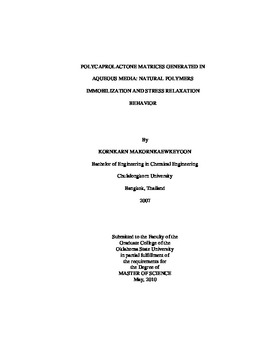| dc.contributor.advisor | Madihally, Sundararajan V. | |
| dc.contributor.author | Makornkaewkeyoon, Kornkarn | |
| dc.date.accessioned | 2014-04-16T03:07:28Z | |
| dc.date.available | 2014-04-16T03:07:28Z | |
| dc.date.issued | 2010-05-01 | |
| dc.identifier.uri | https://hdl.handle.net/11244/9646 | |
| dc.description.abstract | This study determined the possibility of immobilizing natural polymers onto self-assembled polycaprolactone (PCL) matrices and its effect on tensile properties of the PCL matrix. The stress relaxation behavior of self-assembled PCL was also investigated by studying the effect of strain rate and natural polymers immobilization. Pseudo-component model was was tested with the experimental data using combinations of pseudo-components in order to find the best fit and gain better understanding of the stress relaxation behavior of self-assembled PCL. The immobilization of natural polymers onto self-assembled PCL matrices was confirmed but the attachment of chitosan porous structure was too weak to be used for tissue regeneration. The immobilized matrices had higher elastic modulus than those of self assembled PCL matrices in both wet and dry conditions. The effect of strain rate, at least in the range used in the experiment (0% s^-1 -3% s^-1) was statistically insignificant on stress relaxation behavior. No statistically significant difference in the stress relaxation behavior was observed after the immobilization of natural matrixes. The proposed reform and retain pseudo-component concepts did not provide the best fit, but all forms of the pseudo-component model showed good fits in multiple stages. This is an improvement over traditional QLV model ability, and shows promise for being the modeling approach suitable for describing viscoelastic behavior of biomaterials. | |
| dc.format | application/pdf | |
| dc.language | en_US | |
| dc.publisher | Oklahoma State University | |
| dc.rights | Copyright is held by the author who has granted the Oklahoma State University Library the non-exclusive right to share this material in its institutional repository. Contact Digital Library Services at lib-dls@okstate.edu or 405-744-9161 for the permission policy on the use, reproduction or distribution of this material. | |
| dc.title | Polycaprolactone Matrices Generated in Aqueous Media: Natural Polymers Immobilization and Stress Relaxation Behavior | |
| dc.type | text | |
| dc.contributor.committeeMember | Rhinehart, R. Russell | |
| dc.contributor.committeeMember | Ramsey, Josh D. | |
| osu.filename | Makornkaewkeyoon_okstate_0664M_10911.pdf | |
| osu.college | Engineering, Architecture, and Technology | |
| osu.accesstype | Open Access | |
| dc.description.department | School of Chemical Engineering | |
| dc.type.genre | Thesis | |
| dc.subject.keywords | chitosan | |
| dc.subject.keywords | gelatin | |
| dc.subject.keywords | polycaprolactone | |
| dc.subject.keywords | stress relaxation | |
| dc.subject.keywords | surface property | |
| dc.subject.keywords | viscoelasticity | |
